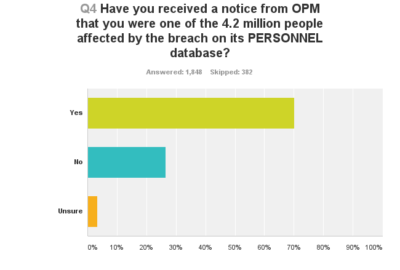
TSP Envy: 0 gets 1 and 4 gets 5!!!
Many private sector types claim they would lop off a key part of their anatomy to be in the Thrift Savings Plan, says Senior Correspondent Mike Causey.
Although some feds take their 401k plan for granted, many private sector types claim they would lop off a key part of their anatomy to be in the Thrift Savings Plan.
Many private sector firms have switched from traditional defined benefit retirement plans to programs where employees — through a 401k plan and Social Security — finance most of their retirement. Many private firms that once matched some of their employees’ 401k plan contributions can no longer afford that luxury.
When Congress set up the FERS retirement program in the 1980s, it had a less generous federal annuity than the CSRS program it replaced. CSRS retirees receive a larger lifetime annuity, indexed to inflation when they retire. FERS employees receive a reduced benefit, and cost of living adjustments for most don’t begin until age 62. Then they can be less than those going to CSRS retirees.
FERS employees receive (and pay for) Social Security benefits. They also have a TSP option that allows them to sock away as much as 5 percent more than CSRS employees. All FERS workers receive an automatic 1 percent from the government. Those who put in 5 percent or more receive a 5 percent match from Uncle Sam. For many private sector types, that is the deal of the century. Some feds, however, think it is blown out of proportion and is rarely fully explained, including here.
Whether the TSP seems too good to be true, or not good enough, investing at least 5 percent should be the goal of every FERS employee. Here’s part of an extended email from a long-time fed who thinks the more people know about the TSP the more likely they will be to participate. He also thinks the media could do a better job of explaining how it works, the government share, etc. He’s definitely done his homework. Check it out:
“I much appreciate the efforts you make to inform feds about the things they need to know to look after their financial and professional interests. Among the things that can’t be said too many times is how people are doing themselves a disservice by not making the minimum 5 percent contribution to get the federal matching contribution. I would respectfully suggest, however, that you slightly amend how you characterize the government matching contribution.
“For the first 3 percent of base pay contributed by the employee, Uncle Sam will of course match that 1-for-1, so that the USG matching will be 3 percent — which, as you and others like benefits expert Tammy Flanagan— often note, is found money, and basically doubles the amount the employee is contributing. Things are a bit different at the 4 percent and 5 percent levels, however, as the federal matching payments are done at only half of the level contributed by the employee. For that 1.0 percent contributed by the employee at the 4 percent level, the USG contribution is 0.50 percent. The same is true at the 5 percent level. The effect is that, if the employee contributes 5 percent, the USG contribution will be equal to 4 percent (and, if it is 4 percent by the employee, 3.5 percent by the USG, and if 3 percent by the employee, 3 percent by the USG).
“It might be helpful for the mantra to be more like this: We should all be sure to contribute 5 percent to get an additional 4 percent in matching funds, rather than 5 percent to get federal matching. It would also better inform our workforce about what exactly they are accruing in the way of benefits — no small thing when the focus by many in Congress seems to be to make political hay at the expense of federal employees’ pocketbooks, and not incidentally, to discount/diminish/disrespect their service to the country and their commitment to their work.
” Again, many thanks to your good work on our behalf. Best summertime wishes to you.
“Regards.” — A Fan
Nearly Useless Factoid:
Ernest Evans is the birth name of singer Chubby Checker.
Source: Wikipedia
Copyright © 2024 Federal News Network. All rights reserved. This website is not intended for users located within the European Economic Area.
Mike Causey is senior correspondent for Federal News Network and writes his daily Federal Report column on federal employees’ pay, benefits and retirement.
Follow @mcauseyWFED



